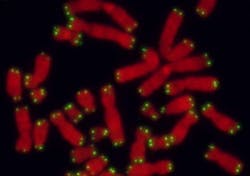Superresolution microscopy makes important telomere biology discovery
Using superresolution microscopy, a team of scientists at the Children's Medical Research Institute (CMRI; Westmead, New South Wales, Australia) and colleagues have made a groundbreaking discovery on the biology of the DNA segments at the ends of every human chromosome, known as telomeres. The finding has implications for conditions ranging from cancer to aging and heart disease.
Related: Fluorescence method links shortened telomeres to dysfunction in muscular dystrophy
As we age, telomere length naturally decreases—over the course of a lifetime, telomere shortening instructs aging cells to stop dividing. Telomere shortening causes chromosomes ends to resemble broken DNA, but it has remained a mystery why telomeres change from healthy to unhealthy with age. This research has identified the underlying cause.
The research project was led by Tony Cesare, Head of the Genome Integrity Unit at CMRI, in collaboration with scientists from CMRI as well as the University of New South Wales Sydney's (UNSW Sydney's) Katharina Gaus.
"We knew that telomeres regulate cellular aging, but our new data explain the trigger that makes telomeres unhealthy," Cesare says. "Telomeres normally form a loop structure, where the chromosome end is hidden. We found that when the telomere loop unfolds, the chromosome end is exposed and the cell perceives this as broken DNA." He continues, "it is not telomere length that matters, but telomere structure. The telomere loop becomes harder to form as telomeres get short."
Superresolution microscopy made it possible to see telomere loops with a microscope. To complete this research, the team used superresolution microscopes at four Sydney research institutions, and purchased the first Airyscan superresolution microscope in Australia. "This technology allowed us to see 10X more detail than we had in the past,’" Cesare says. "We could pass the physical limits of light and see the telomere-loop structure."
To complete the project, the research team combined this breakthrough technology with powerful genetic models that mimic cellular aging. The team also identified that telomeres can also change structure in response to some chemotherapeutic agents, which helps kill cancer cells.
"We've shown that it’s not just telomere length, but telomere structure and telomere health that we need to understand. The next step is to ask, can we correlate human health with telomere health? Our work suggests there is more to the story than just measuring telomere length," Cesare says.
Full details of the work appear in the journal Molecular Cell.
